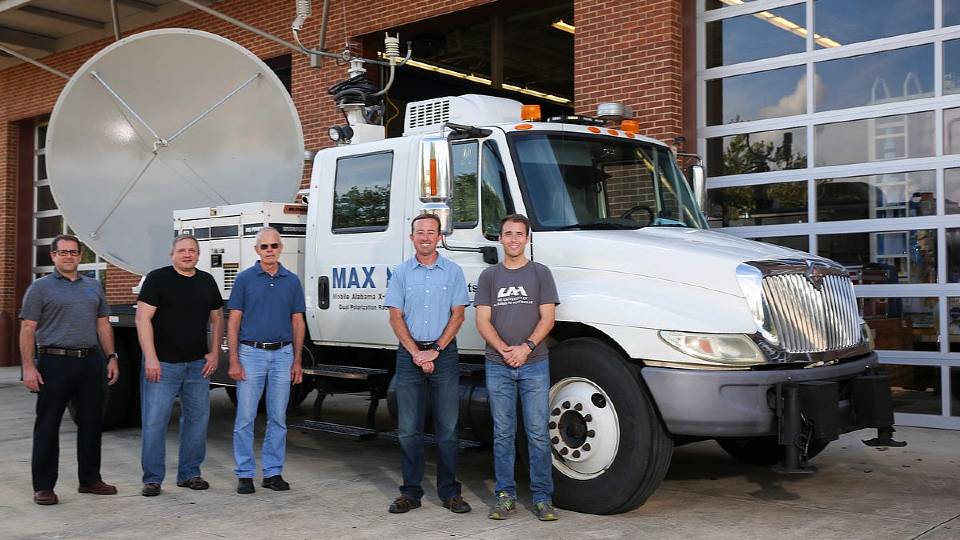
From left, Dr. Ryan Wade, Dr. Larry Carey, Dr. Kevin Knupp, Dustin Phillips and Preston Pangle stand near MAX, the Mobile Alabama X-band radar, part of the UAH MAPNet equipment being offered to other atmospheric researchers.
Michael Mercier | UAH
A plan by three Department of Atmospheric and Earth Science faculty to offer University of Alabama in Huntsville (UAH) atmospheric measuring instruments and equipment to other atmospheric researchers has already proven to be exceptionally popular.
The effort is funded by a five-year, $1.23 million National Science Foundation (NSF) grant.
Principal investigator (PI) Dr. Kevin Knupp, a professor of atmospheric and Earth science at UAH, a part of the University of Alabama System, joined with co-PIs Dr. Lawrence (Larry) Carey, professor of atmospheric and Earth science, and Mr. Ryan Wade, atmospheric and Earth science clinical assistant professor, to make the proposal to the NSF.
It includes support staff and also use of the facilities at UAH’s Severe Weather Institute - Radar & Lightning Laboratories (SWIRLL).
“It has taken off,” says Dr. Knupp. “Within one week of the kickoff meeting with NSF, we had a first inquiry for a project called CREST that is proposed to take place in Arizona to investigate the North American monsoon, changes in the lower atmosphere, and the initiation and evolution of thunderstorms that frequently reach severe levels with strong wind, heavy rain and lightning.”
UAH’s Mobile Atmospheric Profiling Network (MAPNet) facility, housed within the UAH SWIRLL facility, includes four mobile platforms: the Mobile Integrated Profiling System (MIPS), the Rapidly Deployable Atmospheric Profiling System (RaDAPS), the Mobile Doppler Lidar and Sounding system (MoDLS), and the Mobile Alabama X-band (MAX) radar.
After the MAPNet name was adopted under the NSF project, the first deployment included the MAX radar and RaDAPS profiling system during the landfall of Hurricane Ida, Dr. Knupp says.
“The next major deployment will be during the PERiLS field campaign (Propagation, Evolution, and Rotation in Linear Storms), during the March-April time frame of 2022 and 2023,” he says.
There’s also the potential for long-term UAH involvement with the U.S. Department of Energy Atmospheric Radiation Measurement (ARM) Mobile Facility deployment in west-central or northwest Alabama, something that Dr. Knupp says would provide benefits to about half of the atmospheric and Earth Science faculty.
“I have had preliminary conversations with others on potential research projects,” he says. “Business has really taken off.”
The UAH funding from NSF comes under a new program called Community Instruments and Facilities that is designed to facilitate wide use of existing instruments and facilities by the NSF-sponsored atmospheric science community. It also funded nine other universities.
The categories for UAH equipment use are research, with one- to two-month deployments; education, with deployments from one to two days to one to two weeks; and outreach, which is activities generally within the southeastern region, including local to the Tennessee Valley, and including SWIRLL tours.
For research and education, scientists can request to use one or all of the four mobile platforms.
“They submit a proposal to NSF and contact us for input,” says Dr. Knupp. “If they are funded, then we submit a subcontract proposal to NSF to provide the service. UAH personnel can also submit a request.”
The NSF money provides one- to two-day project support for pilot studies that may be needed for research proposals and keeps UAH’s instruments in deployment-ready condition. It will also be used for education and outreach events within mostly 150 miles of Huntsville.
“NSF strongly encourages outreach for K-12, historically black colleges and universities, and smaller universities and colleges,” Dr. Knupp says. “We now have base funding to do this more effectively.”
The arrangement offers some major advantages to UAH and other MAPNet users. One is that the cost of fielding instruments is not part of the NSF research proposal, but rather is derived from a separate NSF program.
“This keeps the NSF research proposal budget lower, and hence more competitive,” Dr. Knupp says. “So, we get extra funds – in the range of $50,000-250,000 – for these deployments.”
Also, the research being done by programs requesting use of the MAPNet facilities will very likely be of scientific interest to UAH.
“This will increase our collaboration with external organizations,” Dr. Knupp says.
Another advantage is that MAPNet base funding will keep the facility in top-notch condition and allow for incremental improvements, as well as providing continual funding for the staff that is not contingent on successive research grant funding.
“This is a big deal! We can do better science, truly cutting edge,” Dr. Knupp says. “It expands our collaborations with other groups, which will translate to more UAH research funding, more research activity, including with UAH students, and more research papers.”